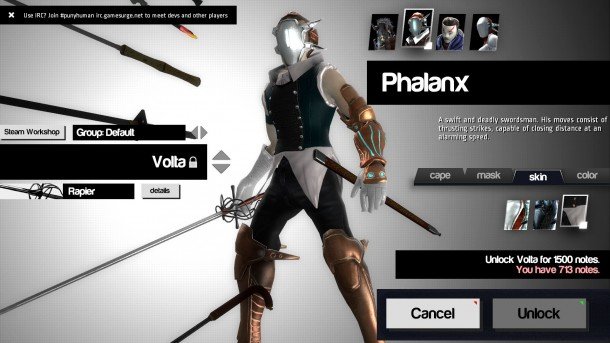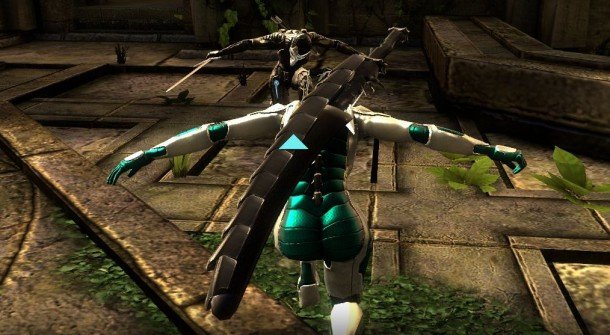Our Verdict
Blade Symphony's duels are electrifying and intimate, more than making up for a lack of content.
PC Gamer's got your back
Price: £11 / $15
Release: May 7
Publisher: Puny Human
Developer: Puny Human
Website: Official site
Multiplayer: Online & LAN
By Will Uhl
The cascading waterfall in the background doesn't distract me from my opponent as I dash and twirl, dancing for my life. My character, the acrobatic assassin Pure, has only managed to land a few glancing blows, while the towering juggernaut I'm fighting, Judgement, has devastated me with only a few well-placed strikes. I'm buzzing around him like a fly around a bull as I try to figure out a way out of this.
Whereas he wields the basic longsword, I chose the katana, which removes my ability to block, but strikes twice as hard after swords clash. I disengage and move several meters away—he wants to finish this, and the wide berth I've given him is the perfect opportunity.
I begin glowing as I charge up a heavy blow. He lunges towards me. Suddenly, I release my attack just as he lashes out with a quick stab. Sparks fly as our steel clangs—he recoils, but my attack follows through, emptying his health bar. As his body floats in the waterfall's pool, he types “good fight” into chat. I bow, and return the sentiment after my hands stop shaking.
That sense of respect is prevalent in Blade Symphony's community. Civility among anonymous online players is itself an anomaly, but to have a sense of honor be the norm is unheard of. There's a deep intimacy in the duels that's rarely found in other games.

Traditional fighting games typically have a roster of two dozen fighters, but Blade Symphony lets you mix and match between four characters and five sword types, all of which stand out against each other. Battles take place in 3D arenas, and while there are a number of extra modes, such as two-on-two and Hero Mode (which pits one superpowered swordsman against the rest of the server), the most memorable matches come from formalised one-on-one fights.
In most competitive games, there's a significant distance between you and your opponent, either from behind an iron sight or some top-down abstraction. It's easy to focus on yourself in these circumstances and treat other players as glorified NPCs. However, when you have to dance within spitting distance of just one opponent, everything else is stripped away. To make an inch of progress, you have to make yourself vulnerable. Few things are truly safe in Blade Symphony, and when one particularly poor decision can mean paying with half of your health bar, carefully analyzing your opponent is critical.
You can change your tactics depending on their character and sword of choice, but the most defining factor is always the player. Though understanding how the matchups work is undeniably important, figuring out how to exploit the gaps in their expertise is infinitely more useful. “How will they react if I do this? Do they know how to counter that? Can I get away with this?” It's science with swords at a breakneck pace: form your hypothesis in the passing moments between clashes of steel, then put your theory to the test.

Those brief pauses are what defines the game's depth and intimacy. Most fighting games reward constant action, but the moments in Blade Symphony when both players step back and observe are some of the most tense in fighting games. That ceaseless psychological war of baiting, reacting, and examining the opponent occurs in many of the best competitive games across all genres, and this one does it with style and finesse.
The music completes the atmosphere and sense of tension. Traditional Japanese strings, piano, and throat singing capture the desperate drama of Blade Symphony's swordfights, while ambient bells and chimes give match spectating a meditative tranquility. It's absolutely worth a separate purchase for any soundtrack enthusiast.
The game's weakest point is simply a lack of variety. Mathematically, there are 20 unique combinations of characters and weapons, but not all combinations play that differently, and some are rarely seen. More are working their way down the pipeline according to the developer, so this issue may lessen over time.

In just about every other area, the community has been able to pick up the slack, thanks to a thorough integration with the Steam Workshop. All weapons have six or seven skins, and each character has a small handful of masks, both of which are earned by winning ranked duels. By comparison, the community has already produced over 200 custom skins and models (of predictably varying quality), as well as new maps, game modes, and an enhanced tutorial, all of which are lacking in the base game.
Even with all of these crowdsourced improvements, there still isn't much to do when tired of duelling. The other game modes are largely underdeveloped and rarely played. However, the saving grace of Blade Symphony is that its duels are thoroughly, distinctively, and consistently exhilarating.
Blade Symphony's duels are electrifying and intimate, more than making up for a lack of content.
PC Gamer is the global authority on PC games—starting in 1993 with the magazine, and then in 2010 with this website you're currently reading. We have writers across the US, Canada, UK and Australia, who you can read about here.



